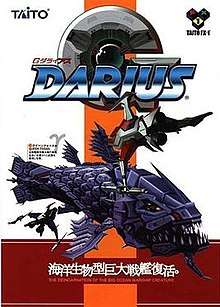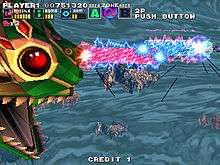G-Darius
G-Darius (Gダライアス, Jī-Daraiasu) is a shoot'em up arcade game, released by Taito in 1997. It is the fourth arcade installment of the Darius series and the first in the series to feature three-dimensional polygonal graphics.
| G-Darius | |
|---|---|
 Arcade flyer | |
| Developer(s) | Taito |
| Publisher(s) |
|
| Platform(s) | Arcade, PlayStation, PlayStation 2, Microsoft Windows, PlayStation Network |
| Release | ArcadePlayStation
|
| Genre(s) | Shoot 'em up |
| Mode(s) | Single-player, multiplayer |
| Arcade system | Taito FX-1B[1] |
| CPU | MIPS R3000A |
| Sound | Panasonic MN1020012A |
Gameplay

Much like previous installments in the Darius series, G-Darius is a horizontally scrolling shoot'em up. While the game features three-dimensional polygonal graphics, the gameplay remains two-dimensional. The player controls a spaceship named the Silver Hawk and must battle enemies and avoid obstacles throughout the game's stages (referred to as "zones" in the game). The ship is armed with forward-firing missiles, small aerial bombs and a protective force field. These can be upgraded by power-ups, in the form of large orbs, that are dropped by specially-colored enemies when they are destroyed. When the player reaches the end of a zone, a boss appears, which must be defeated to proceed. Once the boss of a zone is destroyed, the player is given a choice of which zone to play next via a branching path.[2][3]
Among the player's arsenal is the 'capture ball', which the player can launch to capture enemies. Once captured, the enemy will follow and aid the player's ship.[4] Each enemy contains a unique enhancement; some will act as extra turrets and others will act as shields. Additionally, the player can detonate their captured enemy as a bomb. The captured enemy will continue to follow the player until either they are destroyed after taking enough damage or the player's ship is destroyed.[2][3][5]
New to the series is the concept of beam-dueling. The player can absorb a captured enemy to fire a powerful laser beam over a short period of time, which will instantly destroy nearly every enemy it comes into contact with. This is primarily used during boss fights. Every major boss in the game has an equivalent laser beam. If the player and the boss fire their lasers simultaneously, a 'duel' between the two will initiate. The player must overwhelm the boss' laser by repeatedly tapping the fire button as quickly as possible. If successful, the boss' beam will eventually dissipate and the player's beam will multiply in size (as well as in power) and severely damage, if not kill, the boss.[2][5]
Ver.2
A second version of the game was released in the arcades in 1999, with the following changes:
- Increased difficulty
- Default play cost is increased to 2 coins per credit from 1 coin per credit
- Added beginner mode. In beginner mode, the game ends after completing only 3 zones
- Standard auto-fire button
- When using a Capture Ball, the player is no longer invulnerable
- With the super shield, the player is vulnerable to obstacles. With the hyper shield, the player can take a single hit from obstacles
- All stages include mid-bosses
- Boss battles include a timer (3 minutes for normal bosses, 7 minutes for the final boss). 10000 bonus points are added for each remaining second after destroying the boss
- The high score table records high scores for each zone
- After continuing, the player is given one of each Missile, Bomb, Arm and Capture Ball powerups instead of a single item that provides the first three
Plot
G-Darius is a prequel story that revolves around a conflict between the humanoids of Amnelia and cyborg/chimera biovessels known as the "Thiima" (meant to mean simply "deliverer of death"). The Thiima had been aroused by the Amnelian army's use of the weapon A.N. (All-Nothing) to annihilate the world Blazar, whom Amnelia had been at war with over jurisdiction over the moon Mahsah. Determined to protect their existence, and long ago programmed to protect the universe from just such threats as A.N., the Thiima swarmed on Amnelia. Although the armed forces were badly ravaged, Amnelian scientists and engineers were able to make use of both A.N. and reverse engineered Thiiman technology/life systems to create the Silver Hawk fighters. Ultimately, two pilots—Sameluck Raida and Lutia Feen—are chosen to perform a decisive attack on the main Thiima base: Kazumn, a satellite of the planet Darius.
Ports
G-Darius was ported to the PlayStation[2] and released in Japan by Taito and in the United States by THQ.[2] The original arcade version of G-Darius was later re-released on the PlayStation 2 port of Taito Legends 2, a compilation consisting of several arcade games by Taito.[6] The Windows 95 version, based on the PlayStation port, was published by CyberFront Corporation, MediaKite, and Sourcenext.
Reception
| Reception | ||||||||||||||
|---|---|---|---|---|---|---|---|---|---|---|---|---|---|---|
| ||||||||||||||
In Japan, Game Machine listed G-Darius on their August 15, 1997 issue as being the fourth most-successful arcade game of the year.[9] Game Machine also listed G-Darius Ver.2 on their November 1, 1997 issue as being the tenth most-successful arcade game of the year.[10]
The PlayStation port received positive reviews. Peter Barthelow of GameSpot awarded the game an 8.3/10.[2] In a 2014 retrospective, Eurogamer called the game "one of the greatest shooting games ever realised".[11]
Next Generation reviewed the PlayStation version of the game, rating it three stars out of five, and stated that "This game is targeted at an ever-shrinking and ever-aging segment of gamers – those who remember Gradius, R-Type, and their ilk, and remember them fondly. G Darius is fun for those fogies who can stomach it, but the average gamer will be bored to death."[8]
References
- "FX-1B System Hardware (Taito)". Retrieved 2011-01-27.
- Bartholow, Peter (1 May 1998). "G Darius Review - GameSpot.com". GameSpot. Archived from the original on 10 July 2012. Retrieved 15 April 2012.
- Nelson, Randy (17 September 1998). "G Darius". IGN. Retrieved 20 July 2011.
- "G Darius". Sega Saturn Magazine. No. 19. Emap International Limited. May 1997. p. 94.
- "Coin-Operated". Sega Saturn Magazine. EMAP (19): 94. May 1997.
- Miller, Greg (4 June 2007). "Taito Legends 2 Review". IGN. Retrieved 2011-01-27.
- "G Darius for PlayStation". GameRankings. CBS Interactive. Retrieved 2018-09-24.
- "Finals". Next Generation. No. 46. Imagine Media. October 1998. p. 128.
- "Game Machine's Best Hit Games 25 - TVゲーム機ーソフトウェア (Video Game Software)". Game Machine (in Japanese). No. 547. Amusement Press, Inc. 15 August 1997. p. 21.
- "Game Machine's Best Hit Games 25 - TVゲーム機ーソフトウェア (Video Game Software)". Game Machine (in Japanese). No. 552. Amusement Press, Inc. 1 November 1997. p. 25.
- Higham, Rupert (30 March 2014). "Darius retrospective". Eurogamer. Gamer Network. Retrieved 31 March 2014.